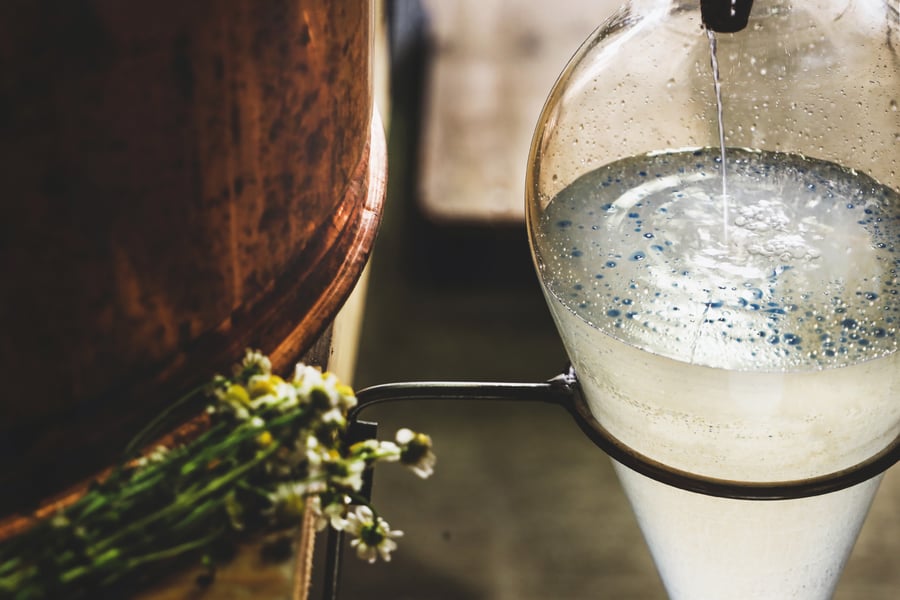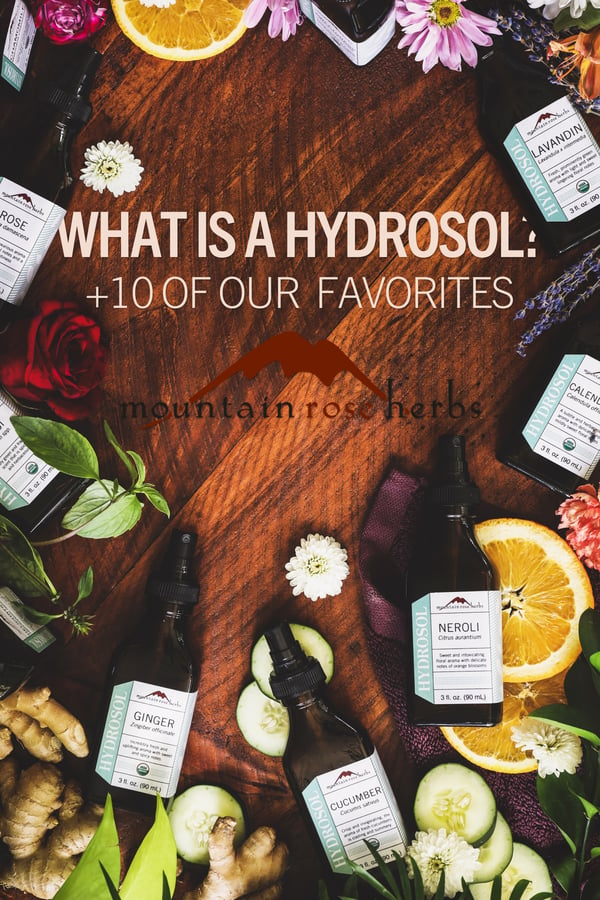Hydrosols are high quality, distilled botanical extracts, not to be confused with the “floral waters” you might have seen for sale that are often just water combined with essential oils. Hydrosols are beloved by the herbal community for their ease of use and versatility in aromatherapy, herbal body care formulations, therapeutic applications, cosmetics, and household recipes. They add variety and scope to our herbal practices, and we appreciate the added safety they give us when working with children, elders, and pets. Although they are made using the same distillation process as essential oils, they are more sustainable because distillers get significantly more hydrosol per distillation. But not all hydrosols are created equally. We’re excited to tell you more about these lovely plant waters.
What is Hydrosol?
Like essential oils, hydrosols are made by distilling fresh plant material—leaves, flowers, rhizomes, fruits, seeds, etc.—a process that captures the pure aromatic “waters” of the plant. Steam passes through the plant material, capturing the aromatics, and flows into a condenser that feeds into a funnel that separates the hydrosol from the much smaller amounts of essential oils that are also extracted. This process gives hydrosols properties similar to essential oils, but their plant-water content makes them less concentrated, so they are gentler and more delicately scented than the oils and can be directly applied to adult skin without first diluting them. If you’ve ever used rose water or orange blossom (neroli) water, then you have used a hydrosol.
To save money, essential oil distillers often collect hydrosols as a byproduct of the essential oil extraction process. However, at Mountain Rose Herbs, we work with artisan distillers at family-owned organic farms that operate a distillery solely for hydrosols. They make our pure hydrosols using only fresh plant material and the strictest organic and distillation standards for the finest end product. They understand that even the smallest irregularities—botanical quality and freshness, cleanliness, the material the stills are made of, etc.—will impact a finished hydrosol.
10 Ways to Use Hydrosols
- Use as a facial toner. Lavender, neroli, and rose hydrosols are often good choices for all skin types. Adults do not need to dilute hydrosols, so you can spritz directly onto your face as a toner after washing and before applying a moisturizer. *Note that it’s always a good idea to dilute a hydrosol by about 50% with water or aloe vera when using with children.
- Use as a makeup remover. Soak a cotton pad with a refreshing hydrosol—for instance, cucumber hydrosol—to help remove makeup and ease redness and puffiness under your eyes. Store hydrosol in the refrigerator for extra cooling comfort.
- Use with a face or body oil instead of using lotion. Simply spritz your skin with a hydrosol, then apply oil while skin is still damp. Hydrosols that are beneficial for all skin types include cucumber, lavender, rose geranium, helichrysum, etc.
- Add hydrosols to facial steams (lavender and chamomile are classic choices) or use as a base for an herbal face mask. Check out these 5 sheet mask recipes (complete with a downloadable mask template) to get you started.
- Replace the water in DIY formulations for lotions, creams, and moisturizers with hydrosol(s). Rose, cucumber, and chamomile are popular choices. This rosehip oil facial moisturizer recipe uses rose hydrosol.
- Add 1 oz. directly to adult bath water or a sitz bath for an aromatic and skin-loving soak. Lavender, rose, chamomile, and neroli are lovely options.
- Mix hydrosols with clay or powdered herbs to make either drawing poultices or soothing poultices for irritated or dry skin.
- Use to make room sprays and linen sprays to freshen your air and provide extra aromatherapeutic benefits throughout your day. This summer breeze linen spray recipe uses both hydrosol and essential oils.
- Use in DIY household cleaning recipes. Peppermint or lemon thyme hydrosols are good choices to wipe down kitchen counters and other surfaces between deeper cleaning sessions.
- Help to keep mosquitoes and other biting bugs at bay. Lavender hydrosol has natural repelling action and is also soothing to the skin and good for use with children. Lemon thyme and eucalyptus can also be good choices for adults.
10 Practical Hydrosols for Aromatherapy, Natural Skin Care & More
Calendula Hydrosol (Calendula officinalis)
Body care professionals love calendula for its skin-rejuvenating properties and soothing, mildly sweet, floral aroma. Calendula hydrosol is a perfect skin toner that may be used alone or included in body care formulations in place of water. Blend with rose hydrosol for an especially fragrant, balancing toner. Use calendula hydrosol directly on your skin after a shower or store a bottle in the refrigerator for a cooling spritz when you’re overly warm. Helichrysum and carrot seed essential oils are good additions to calendula hydrosol for added skin health support.
Chamomile Hydrosol (Matricaria recutita)
This flowering herb is best known for its gentle ability to help us relax and has been used for thousands of years in skincare formulations and for minor skin irritations. The aroma of chamomile hydrosol is pronounced and is markedly different from the fresh flowers or essential oil. It can be used alone and may be used in place of water as a base for DIY creams and lotions. Chamomile hydrosol blends well with frankincense or rose hydrosols to make a wonderfully aromatic and balancing skin toner.
Cucumber Hydrosol (Cucumis sativus)
At 97% water, cucumbers are ideal botanicals for general hydration and hydrosol distillation. Cucumber hydrosol has a crisp, refreshing aroma and makes a cool and rejuvenating botanical spray, so is perfect as a summer body splash. This skin-softening and toning hydrosol is also a wonderful addition to homemade lotions, aroma sprays, makeup removers, after-shower mists, and other DIY body care formulations in which you can use hydrosol in place of water. Blend with aloe vera gel for a wonderfully cooling combination.
Ginger Hydrosol (Zingiber officinale)
Ginger hydrosol has uplifting, warming properties and an alluring scent of freshly cut ginger root. Use alone as a light body mist or use in place of water in body care formulations and aroma sprays. Combine with lime, turmeric, or blood orange hydrosols for tropical-inspired DIY creams and lotions, or with lavender and peppermint essential oils to make a zesty mist to wake up your brain. Enhance the brightness of ginger hydrosol by combining it with spicy essential oils such as fennel, eucalyptus, cardamom, and black pepper. Mountain Rose Herbs’ ginger hydrosol contains 1,8-cineole, neral, geranial, and geraniol, so this is also a good addition to DIY cleaning recipes.
Helichrysum Hydrosol (Helichrysum italicum)
Sometimes called “everlasting,” helichrysum is known for its restorative and analgesic properties in skin care. It is considered energetically uplifting and grounding, and has a dry, green, floral aroma with slightly sweet, earthy back notes. Its ability to enhance the skin’s natural health makes it a classic ingredient in DIY formulations for mature or sensitive skin. It is also soothing for irritated, dry, or itchy skin. Use directly on problem areas or add to facial toners, after-shower sprays, etc. Combine with lavender and aloe vera for extra skin-supporting properties. This is also a lovely linen spray and can replace water in perfume blends.
Lavender Hydrosol (Lavandin - Lavandula x intermedia)
Our lavandin hydrosol has all the same relaxing, balancing qualities as the classic Lavandula angustifolia. It is considered mentally refreshing and emotionally uplifting. It is a good choice for all skin types, and is wonderful for cooling and soothing irritated skin. This hydrosol has a somewhat green aroma with a lightly sweet floral top note. It can be used alone as a skin-toning mist or blended with other hydrosols and essential oils in room and linen sprays, facial toners, after-shower sprays, and more. To enhance its herbal bouquet, combine with rosemary and juniper. This aromatic hydrosol is also an excellent addition to DIY cleaning solutions.
Neroli Hydrosol (Citrus aurantium)
Neroli is a sweet essence extracted from orange blossoms. The hydrosol has a much softer scent than the essential oil, with a beautiful, seductive fragrance that is a staple in the perfume industry. Because neroli hydrosol is astringent, it can be used alone as a delightful toner and aftershave, or in place of water in lotion and body cream blends for all skin types. Its calming, grounding aroma is complemented by citrusy essential oils like orange, petitgrain, and mandarin for refreshing aroma sprays or room sprays. When mixed with rose, sandalwood, or coriander, neroli hydrosol lends itself to alluring scent blends that are said to be good for the heart.
Rose Hydrosol (Rosa damascena)
Rose hydrosol has a rich, summery, heady aroma that is uplifting, balancing, and calming. Used alone, it is mildly astringent, and is a good choice for any skin type in facial toners and after-shower mists. It may be used in place of water in body care recipes and is especially loved by those with sensitive or mature skin in face masks and creams. To increase the floral bouquet, combine with hydrosols such as rose geranium or lavandin. For a sweet and woody aroma, combine with sandalwood and benzoin essential oil. Or spark your creativity by combining this hydrosol with chamomile, helichrysum, or jasmine essential oil.
Sweetgrass Hydrosol (Hierochloe odorata)
Sometimes known as “holy grass” and the “hair of Mother Earth,” sweetgrass is a sacred herb for many First Nations peoples, and has been historically used in churches and homes to sweeten the air and clear stagnant energy. Sweetgrass hydrosol has a green undertone with wonderful notes of honey and vanilla. It is powerfully aromatic, and its longtime spiritual use makes it an excellent choice to use in spaces intended for meditation, prayer, and ritual. This hydrosol makes a refreshing room spray and its coumarin content gives it a naturally sweet scent that is especially lovely when added to lotions and body creams in place of water.
Tulsi Hydrosol (Ocimum spp.)
Tulsi, also known as holy basil, is a richly aromatic herb that is highly venerated in Ayurvedic practices. Tulsi hydrosol’s aroma is mildly spicy with herbaceous overtones. Energetically, it is cleansing, supportive, and encourages a calm state of mind, so makes a good grounding base for body care formulations and is an excellent choice to mist into the air or to use in a diffuser to clear the energy in a living or workspace. Use it alone as a toning facial and body mist or as a good, not-overly-flowery aftershave. Blend with rosemary or thyme essential oil to add an herbal element or with essential oils like cardamom, black pepper, or cinnamon leaf for a spicier blend.
Want to try another of our favorite hydrosols?
Read About Refreshing Ways to Use Organic Sage Hydrosol!
You may also enjoy:
- Hydrosols: Farm to Bottle
- A Still Life: Hydrosol Distillation with Our Organic Growers
- Blending with Ginger Essential Oils & Hydrosol













